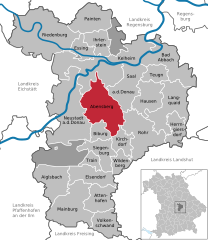Abensberg
Since the administrative reforms in Bavaria in the 1970s, the town also encompasses the following Ortsteile: There had been settlement on this part of the Abens river since long before the High Middle Ages, dating back to Neolithic times.
In 1256, the castrum of Abensprech was first mentioned, and on 12 June 1348, Margrave Ludwig of Brandenburg, and his brother, Duke Stephen of Bavaria, raised Abensberg to the status of a city, giving it the right to operate lower courts, enclose itself with a wall and hold markets.
Abensberg then lost its independence and became a part of the Duchy of Bavaria, and from then on was administered by a ducal official, the so-called caretaker.
The castle of Abensberg was destroyed during the Thirty Years' War, although the city had bought a guarantee of protection from the Swedish general, Carl Gustaf Wrangel.
During the War of the Spanish Succession emperor Leopold I, who had occupied Bavaria, granted the fief of Abensberg to count Ernst von Abensperg und Traun (1608–1668) from an Austrian noble family named Traun that now received the name of the former counts of Abensberg (who were believed to be distant relatives).
In the Battle of Abensberg on 19–20 April 1809, Napoleon gained a significant victory over the Austrians under Archduke Ludwig of Austria and General Johann von Hiller.
With the death of the last Count, Nicholas of Abensberg, in 1485, the estates fell to the Duchy of Bavaria-Munich, meaning that henceforth only the Bavarian coat of arms was ever used.
On 31 December 1809, a decree of King Maximilian of Bavaria granted the city a new coat of arms, as a recognition of their (mainly humanitarian and logistic) services in the Battle of Abensberg the same year.
The diagonally divided field in silver and black came from the old crest of the Counts of Abensberg, while the white and blue diamonds came from that of the House of Wittelsbach, the rulers of Bavaria.
In addition to asparagus, the production of hops plays a major role locally, the region having its own label, and there are still three independent breweries in the area.
Since 2007, the Kelheim Berufsschule has had a campus in Abensberg, and outside the state sector is the St. Francis Vocational Training Centre, run by a Catholic youth organisation.
In the nineteenth century, Nicholas Stark und Peter Paul Dollinger began a collection based on local history.
Up until the 1950s, Abensberg and the surrounding villages contained a number of graves of victims of a Death March in the spring of 1945 from the Hersbruck sub-camp of the Dachau concentration camp, who were either murdered by the SS or died of exhaustion.



